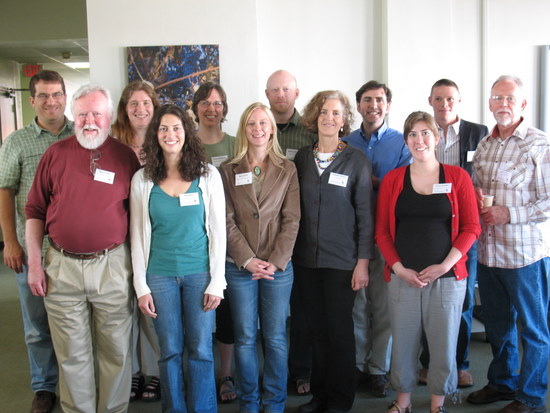NCEAS Working Groups
Monarch butterflies as a model for understanding the spatiotemporal dynamics of migratory species and their response to environmental change
Project Description
Each year, North American monarch butterflies undergo a spectacular two-way long-distance migration from breeding locations in Canada and the United States to overwintering sites in Mexico. A substantial western population overwinters along the coast of California. Throughout their annual cycle of breeding, migrating, and overwintering, monarchs require different resources at different life stages. Their shifting spatial distribution poses challenges for identifying the key factors that affect monarch population dynamics and, thus, assessing their conservation status. Multiple long-term monarch monitoring programs span timescales of up to 30 years, and collect data on all stages of the monarch life cycle, including egg, larva, and adult density; migration patterns; and disease prevalence. This wealth of data provides an opportunity to understand how natural and anthropogenic factors affect the population dynamics and movement patterns of monarchs in particular, and migratory species in general. To maximize the value of existing data, it will be important to integrate data sets for analysis and interpretation of both within-season and longer-term population trends. This working group will:
1. explore data sets from throughout the monarchs annual life cycle to identify the major biological and environmental mechanisms that shape large-scale patterns of abundance and movement
2. predict the consequences of human activities, including shifting agricultural practices, deforestation and climate change, on long-term monarch population dynamics
3. create a web-based portal that allows public access to and use of monarch butterfly observational data, much of which has been collected by volunteer observers
Although our efforts focus primarily on a single species, our questions, approaches and findings will have great relevance in understanding the dynamics of other pollinator species and neotropical migrants across North America.

Principal Investigator(s)
Sonia Altizer, Karen S. Oberhauser, Leslie Ries
Project Dates
Start: April 9, 2010
End: May 22, 2011
completed
Participants
- Sonia Altizer
- University of Georgia
- Becky Bartel
- North Carolina State University
- Rebecca V. Batalden
- University of Minnesota, Twin Cities
- James Battin
- Unknown
- Lincoln Brower
- Sweet Briar College
- Andrew Davis
- University of Georgia
- Erica Fleishman
- University of California, Santa Barbara
- Dennis Frey
- California Polytechnic State University, San Luis Obispo
- Elizabeth Howard
- Journey North
- Kelly Nail
- University of Minnesota
- Nathan P. Nibbelink
- University of Georgia
- Karen S. Oberhauser
- University of Minnesota, Twin Cities
- A. Townsend Peterson
- University of Kansas
- Eduardo Rendon
- World Wildlife Fund Mexico
- Leslie Ries
- University of Maryland, College Park
- Monte P. Sanford
- EchoHawk Law Offices
- Orley R. Taylor
- University of Kansas
- Louie H. Yang
- University of California, Davis
- Elise Zipkin
- US Geological Survey (USGS)
Products
-
Journal Article / 2011
Animal migration and infectious disease risk
-
Journal Article / 2014
Unexpected phenological responses of butterflies to the interaction of urbanization and geographic temperature
-
Book Chapter / 2015
Tracking the fall migration of eastern monarchs with Journey North roost sightings: New findings about the pace of fall migration
-
Journal Article / 2012
Milkweed loss in agricultural fields because of herbicide use: effect on the monarch butterfly population
-
Book Chapter / 2015
Contributions to Monarch Biology and Conservation through Citizen Science: 70 Years and Counting
-
Book Chapter / 2015
Connecting Eastern Monarch Population Dynamics Across their Migratory Cycle
-
Journal Article / 2012
Tracking climate impacts on the migratory monarch butterfly
